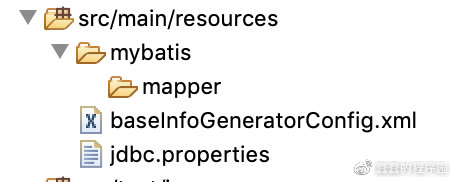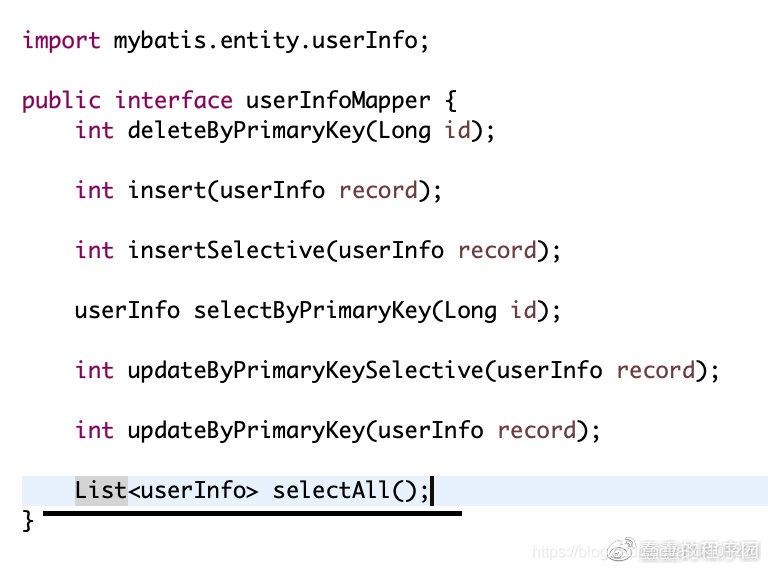MyBatis逆向工程生成dao层增删改查
如下:
int countByExample(BUserExample example); //根据条件查询数量
/**
* 示例
* public int countByExample() {
* BUserExample userExample = new BUserExample();
* BUserExample.Criteria criteria = userExample.createCriteria();
* criteria.andUsernameEqualTo("fan");
* int count = userMapper.countByExample(userExample);
* return count;
* }
* 相当于:select count(*) from user where username = 'fan'
*/
int deleteByExample(BUserExample example); //根据条件删除数据(一条或多条)
/**
* 示例
* public int deleteByExample() {
* BUserExample userExample = new BUserExample();
* BUserExample.Criteria criteria = userExample.createCriteria();
* criteria.andUsernameEqualTo("fan");
* int count = userMapper.deleteByExample(userExample);
* return count;
* }
* 相当于:delete from user where username = 'fan'
*/
int deleteByPrimaryKey(Integer id); //根据主键删除数据
int insert(BUser record); //插入数据(插入一条数据)
int insertSelective(BUser record); //插入数据(插入一条数据,只插入不为null的字段,不会影响有默认值的字段)
List<BUser> selectByExample(BUserExample example); //根据条件查询数据
/**
* 示例:
* public List<BUser> getList() {
* BUserExample userExample = new BUserExample();
* BUserExample.Criteria criteria = userExample.createCriteria();
* criteria.andUsernameEqualTo("fan");
* userExample.setOrderByClause("username desc");
* List<BUser> users = userMapper.selectByExample(userExample);
* return users;
* }
* 相当于:select * from user where username = 'fan' order by username desc
*/
BUser selectByPrimaryKey(Integer id); //根据主键查询
int updateByExampleSelective(@Param("record") BUser record, @Param("example") BUserExample example); //按条件更新值不为null的字段
/**
* 示例:
* public int updateByParam(String username) {
* BUserExample userExample = new BUserExample();
* BUserExample.Criteria criteria = userExample.createCriteria();
* criteria.andUsernameEqualTo(username);
* BUser user = new BUser();
* user.setNickname("jdk");
* int update = userMapper.updateByExampleSelective(user, userExample);
* return update;
* }
* 相当于:update user set nickname = 'jdk' where username = #{username}
*/
int updateByExample(@Param("record") BUser record, @Param("example") BUserExample example); //按条件更新
int updateByPrimaryKeySelective(BUser record); //根据主键与条件更新
/**
* 示例:
* public int updateByIdAndParam(String username) {
* BUser user = new BUser();
* user.setId(101);
* user.setUsername(username);
* int update = userMapper.updateByPrimaryKeySelective(user);
* return update;
* }
* 相当于:update user set username = #{username} where id = 101
*/
int updateByPrimaryKey(BUser record); //根据主键更新
Mybatis反向工程的使用
为什么要使用反向工程,因为,快啊。运行一下就可以自动生成,实现,一堆表的增删查改,等于多了个人帮忙工作,为什么不呢 ?
但与别的工具一样,自动生成的东西总是有方便的地方,也会有麻烦的地方。所以,使用前要留点心眼。要不工具变负累,对个人还好 对团队就变祸害了。
因此,下面的教程除了说如何使用,还会说 一个比较重要的技巧和心得,如果有更好的方法,或我说的有什么不对,请直接指出。谢谢
如有问题可以在下面留言,但我不一定有时间回复。
首先,用eclipse 建一个maven 项目

建一个maven 项目

打好勾点next

填好点finish

这时我们的项目结构是这个样子的
打开pom.xml 文件
把如下内容复制进去:
<project xmlns="http://maven.apache.org/POM/4.0.0" xmlns:xsi="http://www.w3.org/2001/XMLSchema-instance" xsi:schemaLocation="http://maven.apache.org/POM/4.0.0 http://maven.apache.org/xsd/maven-4.0.0.xsd">
<modelVersion>4.0.0</modelVersion>
<groupId>cc.com</groupId>
<artifactId>autoMybatis</artifactId>
<version>0.0.1-SNAPSHOT</version>
<dependencies>
<!-- mybatis依赖 -->
<dependency>
<groupId>org.mybatis</groupId>
<artifactId>mybatis</artifactId>
<version>3.2.5</version>
</dependency>
<!-- 反向工程支持包 -->
<dependency>
<groupId>org.mybatis.generator</groupId>
<artifactId>mybatis-generator-core</artifactId>
<version>1.3.2</version>
</dependency>
<!-- mysql 驱动 -->
<dependency>
<groupId>mysql</groupId>
<artifactId>mysql-connector-java</artifactId>
<version>5.1.38</version>
</dependency>
</dependencies>
</project>
然后新建如下包:

mybatis.dao (用于放mapper 的java 接口)
mybatis.entity (用于放实体对象)
在src/main/resources 下新建目录mybatis及它的子目录mapper
新建baseInfoGeneratorConfig.xml文件
新建jdbc.properties文件

拷贝如下内容进jdbc.properties 要改为正确地址,用户名, 密码
jdbc.driver=com.mysql.jdbc.Driver jdbc.url=jdbc:mysql://localhost:3306/base_info?useSSL=false jdbc.username=root jdbc.password=自已改密码
拷如下内容进入baseInfoGeneratorConfig.xml
<?xml version="1.0" encoding="UTF-8"?>
<!DOCTYPE generatorConfiguration
PUBLIC "-//mybatis.org//DTD MyBatis Generator Configuration 1.0//EN"
"http://mybatis.org/dtd/mybatis-generator-config_1_0.dtd">
<generatorConfiguration>
<properties resource="jdbc.properties" />
<context id="sqlserverTables" targetRuntime="MyBatis3">
<!-- 生成的pojo,将implements Serializable-->
<plugin type="org.mybatis.generator.plugins.SerializablePlugin"></plugin>
<commentGenerator>
<!-- 是否去除自动生成的注释 true:是 : false:否 -->
<property name="suppressAllComments" value="true" />
</commentGenerator>
<!-- 数据库链接URL、用户名、密码 -->
<jdbcConnection driverClass="${jdbc.driver}"
connectionURL="${jdbc.url}"
userId="${jdbc.username}"
password="${jdbc.password}">
</jdbcConnection>
<!--
默认false,把JDBC DECIMAL 和 NUMERIC 类型解析为 Integer
true,把JDBC DECIMAL 和 NUMERIC 类型解析为java.math.BigDecimal
-->
<javaTypeResolver>
<property name="forceBigDecimals" value="false" />
</javaTypeResolver>
<!--
生成model模型,对应的包路径,以及文件存放路径(targetProject),targetProject可以指定具体的路径,如./src/main/java,
也可以使用“MAVEN”来自动生成,这样生成的代码会在target/generatord-source目录下
-->
<!--<javaModelGenerator targetPackage="com.joey.mybaties.test.pojo" targetProject="MAVEN">-->
<javaModelGenerator targetPackage="mybatis.entity" targetProject="./src/main/java">
<property name="enableSubPackages" value="true"/>
<!-- 从数据库返回的值被清理前后的空格 -->
<property name="trimStrings" value="true" />
</javaModelGenerator>
<!--对应的mapper.xml文件 -->
<sqlMapGenerator targetPackage="mybatis.mapper" targetProject="./src/main/resources">
<property name="enableSubPackages" value="true"/>
</sqlMapGenerator>
<!-- 对应的Mapper接口类文件 -->
<javaClientGenerator type="XMLMAPPER" targetPackage="mybatis.dao" targetProject="./src/main/java">
<property name="enableSubPackages" value="true"/>
</javaClientGenerator>
<!-- 你可以改成一张数据库中真正存在的表
schema 指的是schema,在mysql 中我发现填错也能跑。tableName 是表名 ObjectName 是对象名-->
<table schema="base_info" tableName="user_info" domainObjectName="userInfo"
enableCountByExample="false" enableUpdateByExample="false" enableDeleteByExample="false"
enableSelectByExample="false" selectByExampleQueryId="false" >
<property name="useActualColumnNames" value="false"/>
</table>
</context>
</generatorConfiguration>
上面的都搞好
现在要写一下代码了
在根目录下建一个 GeneratorSqlmap.java 的JAVA 类

然后把以下内容覆盖 GeneratorSqlmap.java 文件
import java.io.File;
import java.util.ArrayList;
import java.util.List;
import org.mybatis.generator.api.MyBatisGenerator;
import org.mybatis.generator.config.Configuration;
import org.mybatis.generator.config.xml.ConfigurationParser;
import org.mybatis.generator.internal.DefaultShellCallback;
public class GeneratorSqlmap {
public void generator(String generatorConfigFilePath) throws Exception{
List<String> warnings = new ArrayList<String>();
boolean overwrite = true;
Class.forName("com.mysql.jdbc.Driver");
//指定 逆向工程配置文件
File configFile = new File(generatorConfigFilePath);
ConfigurationParser cp = new ConfigurationParser(warnings);
Configuration config = cp.parseConfiguration(configFile);
DefaultShellCallback callback = new DefaultShellCallback(overwrite);
MyBatisGenerator myBatisGenerator = new MyBatisGenerator(config,
callback, warnings);
myBatisGenerator.generate(null);
}
public static void main(String[] args) throws Exception {
try {
GeneratorSqlmap generatorSqlmap = new GeneratorSqlmap();
//这里要填对配置文件路径
generatorSqlmap.generator("src/main/resources/baseInfoGeneratorConfig.xml");
} catch (Exception e) {
e.printStackTrace();
}
System.exit(0);
}
}
最后运行,GeneratorSqlmap.java ,然后刷新一下项目,就可以得到非常漂亮的,表的entity,mapper interface,mapper xml

以上的代码可以在下面的github链接中找到
现在我们分享一个,能让自动生成和手工修改和平共存的方法。
为什么要和平共存,因为,在数据库表中要加或减一个字段,重复自动生成有可能覆盖掉原来的。
这里有个经过实验的方案,首先在我们生成完第一次没有问题后,把baseInfoGeneratorConfig.xml 中的生成pojo(entity 你爱叫什么叫什么)
<!--
生成model模型,对应的包路径,以及文件存放路径(targetProject),targetProject可以指定具体的路径,如./src/main/java,
也可以使用“MAVEN”来自动生成,这样生成的代码会在target/generatord-source目录下
-->
<!--<javaModelGenerator targetPackage="com.joey.mybaties.test.pojo" targetProject="MAVEN">-->
<javaModelGenerator targetPackage="mybatis.entity" targetProject="./src/main/java">
<property name="enableSubPackages" value="true"/>
<!-- 从数据库返回的值被清理前后的空格 -->
<property name="trimStrings" value="true" />
</javaModelGenerator>
还有生成接口的
<!-- 对应的Mapper接口类文件 -->
<javaClientGenerator type="XMLMAPPER" targetPackage="mybatis.dao" targetProject="./src/main/java">
<property name="enableSubPackages" value="true"/>
</javaClientGenerator>
的注掉
然后,不要修改系统自动生成的 mapper.xml

(可以为配置文件中改个特别一点的名字(例如带上sys),跟团队的成员说一下就可以了。
然后,别外写一个XML mapper 用于开发

只要namespace 是相同的,还是会在对应的接口中生成
例如,我们在新的xml文件中这样写

只需要在系统生成的JAVA接口中增加:

这样一来,如果数据库需要增加字段。只需简单的三步就可以。
- 一,把系统生成的配置文件删了。
- 二,运行自动生成。
- 三,把新加的字段在对应的pojo(或叫entity 中增加)
就可以,很好的把自动生成和手工修改做出分离。同时也会减少很多不应该出现的错误。
以上为个人经验,希望能给大家一个参考,也希望大家多多支持自学编程网。

- 本文固定链接: https://zxbcw.cn/post/219860/
- 转载请注明:必须在正文中标注并保留原文链接
- QQ群: PHP高手阵营官方总群(344148542)
- QQ群: Yii2.0开发(304864863)
